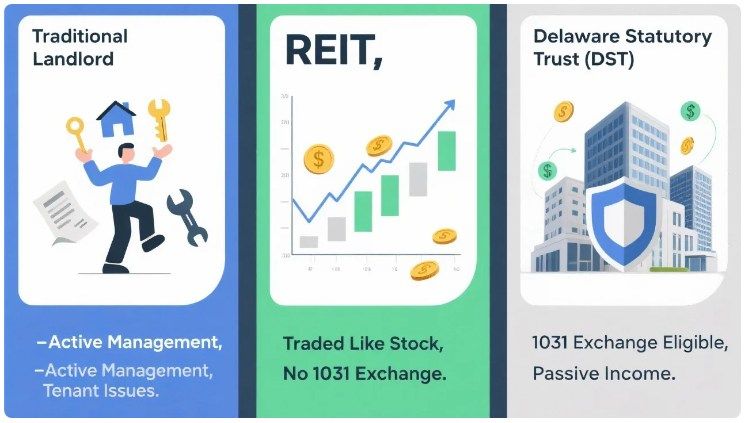Delaware Statutory Trusts for Investors
Delaware Statutory Trusts in 2025: A Passive Income Path for Los Angeles Investors
For many Los Angeles property owners, the combination of high property values, complex regulations, and rising capital gains taxes makes transitioning from active to passive real estate increasingly attractive. One strategy growing in popularity is the Delaware Statutory Trust (DST)—a structure that allows investors to access institutional-grade real estate with 1031 exchange tax deferral benefits while eliminating the burdens of direct property management.

What Is a Delaware Statutory Trust (DST)?
A DST is a legal entity that pools money from multiple investors to buy and manage large-scale commercial real estate properties such as:
Class A multifamily communities with hundreds of units
- Industrial logistics centers, which remain in high demand post-pandemic
- Grocery-anchored retail and medical office buildings seen as recession-resilient assets
Unlike Real Estate Investment Trusts (REITs), DST investors hold a beneficial ownership interest in real property, which qualifies as “like-kind” for IRS 1031 exchanges. This makes DSTs particularly valuable for Californians who face combined state and federal capital gains taxes of up to 37%.
Why DSTs Appeal to Los Angeles Investors
1. Tax Deferral & Wealth Preservation
By exchanging into a DST, investors can defer capital gains on appreciated properties while maintaining income-producing real estate exposure. With California’s 13.3% state capital gains rate on top of federal tax, this is often worth hundreds of thousands of dollars at sale.
2. Institutional Quality Assets
DSTs give individual investors access to
assets typically reserved for institutions—such as a $200 million apartment development in Austin or a multi-tenant logistics park near Dallas-Fort Worth Airport.
3. Professional Management
Sponsors—firms that manage DSTs—handle leasing, maintenance, financing, and compliance. Many operate portfolios worth billions of dollars nationwide, leveraging scale, tenant relationships, and credit analysis that an individual landlord cannot replicate.
4. Geographic Diversification
Los Angeles investors can reduce risk by spreading funds into multiple regions. Many seek growth corridors like Texas, Florida, the Carolinas, and Arizona, where rent growth often exceeds Los Angeles averages.
5. Passive, Predictable Income
Many DSTs aim for 4–7% annual cash distributions. For retirees or time-strapped professionals, this transforms unpredictable rental headaches into a reliable income stream.
Recent Developments in 2025
- IRS Compliance Enforcement:
Regulators have increased oversight of DST structures to ensure they meet 1031 eligibility rules. Investors should work only with registered, experienced sponsors.
- Industrial and Multifamily Growth: Industrial space tied to e-commerce and southern U.S. multifamily complexes are dominating new DST portfolios, reflecting national demand and population trends [source: CBRE, 2025].
- Wealth Migration from California: According to a 2025 U.S. Census Bureau report, California continues to see outmigration toward lower-tax states, a trend fueling DST-based 1031 exchanges into Sun Belt markets.
- Olympics-Driven Demand: With the 2028 L.A. Olympics approaching, many local owners are selling into strong valuations and repositioning wealth through DSTs to avoid hospitality uncertainty and regulatory risk surrounding short-term rentals.
Risks and Limitations
- Illiquidity: Investors should expect a 5–10 year hold period before the property is
sold.
- Limited Control: All decisions are in the sponsor’s hands—investors cannot direct leasing, refinancing, or exit timing.
- Fees: Acquisition and management fees are typically higher than direct ownership.
- Market Dependency: DST returns hinge on the specific properties; downturns in retail, office, or regional economies may impact yields.
Who Is a Good Candidate for DSTs?
- Retiring landlords tired of tenant calls and maintenance issues
- Los Angeles investors with highly appreciated rental properties
- Families looking to diversify wealth outside California real estate
- Accredited investors seeking alternative, income-producing real estate
- Those planning long-term, hands-off wealth preservation strategies
Case Study – From Duplex to Diversified DST Portfolio
A Los Angeles landlord sells a duplex in Culver City for $2.5 million, realizing a $1.2 million capital gain. By rolling into a DST portfolio spanning a Texas multifamily complex,
an Arizona logistics facility, and a Florida medical office center, they:
- Defer ~$400,000 in capital gains tax
- Begin receiving $10,000 in monthly passive income
- Spread risk across 3 states and multiple tenant anchors
DSTs vs. Alternatives
- DSTs vs. REITs: DSTs qualify for 1031 exchanges; REITs do not.
- DSTs vs. Triple Net Leases: DSTs offer diversification; single NNN leases tie investors to one property/tenant.
- DSTs vs. Crowdfunding: DSTs are overseen by established institutions; many crowdfunding platforms vary in sponsor quality.
Final Takeaway
For Los Angeles investors navigating high home values, rising taxes, and mounting housing regulations, DSTs offer a scalable, tax-efficient, and professionally managed pathway into national real estate markets.
They are not for everyone—the illiquidity and lack of control require careful consideration. But for many, especially those selling appreciated California properties, DSTs are proving
to be a bridge from active landlordship to true passive income.
Categories
Recent Posts










GET MORE INFORMATION

